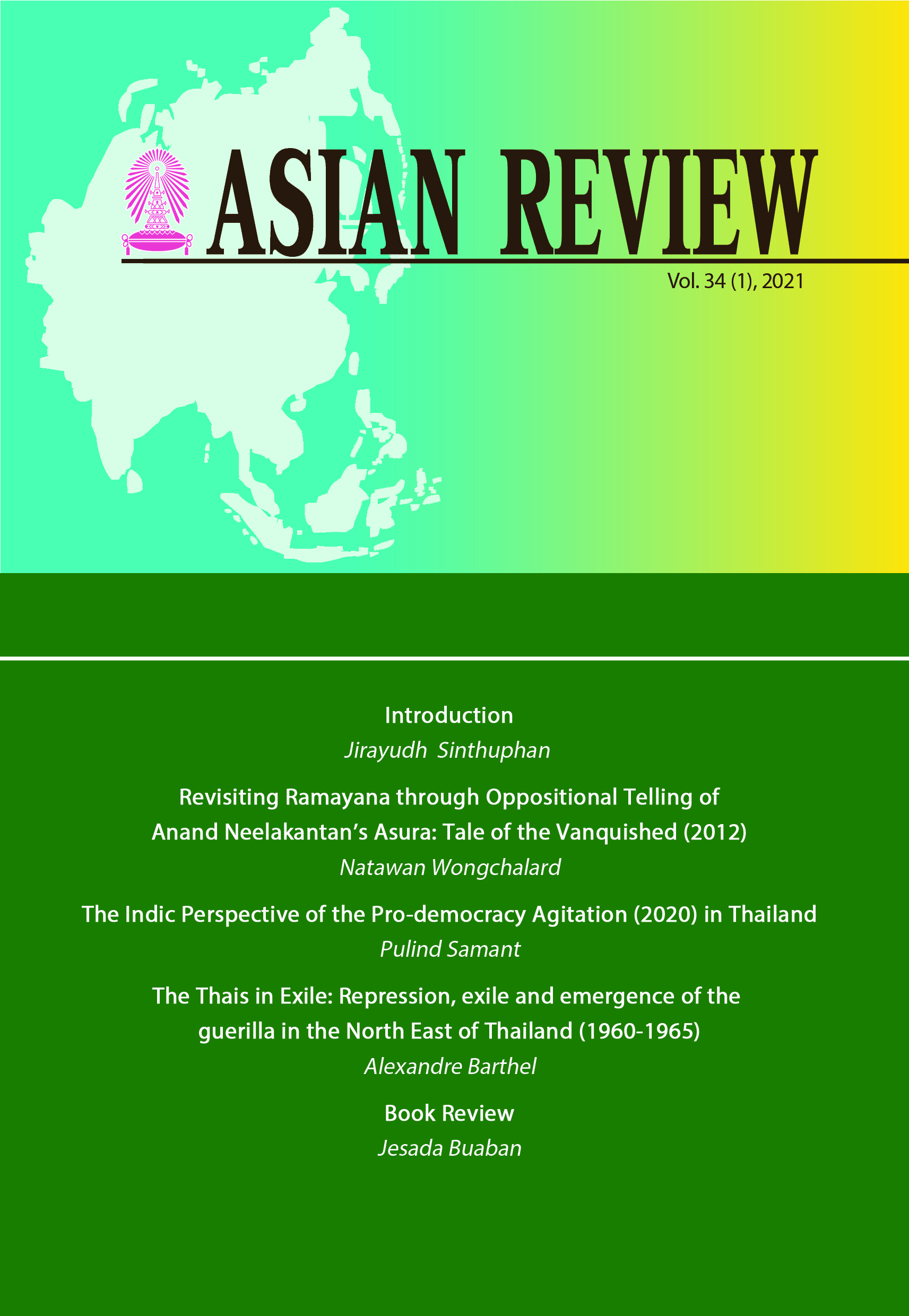Revisiting Ramayana through Oppositional Telling of Anand Neelakantan’s Asura: Tale of the Vanquished (2012)
Keywords:
Ramayana, oppositional telling, subaltern studies, autonomyAbstract
The Ramayana is a well-known epic in India. It is also widely recognized in many other regions around the world. The myriad forms of presentation of this epic allow for a collective audience’s imagination to thrive and rise. Oppositional tellings of the original storyline make the epic even more intriguing as it caters to the ‘other voices’, who have alternative opinions of Rama and who happen to perceive the epic from differing ideological positions that are in contrast to the original version. Through the Ramayana’s oppositional telling, this article is an attempt to represent the identity of Asura (the Deva’s enemy) and also to demystify Rama’s goodness by analyzing the portrayals of the two main characters, Ravana and Bhadra, in Anand Neelakantan’s popular novel, Asura: Tale of the Vanquished (2012). Employing a subaltern studies approach and concepts of autonomy and lack of, the study reveals that Rama’s goodness is in question as it merely reflects a Brahminical worldview that actually stands in contrast with those of the Asuras and other non-Brahmin-Hindu believers.
References
Brahminpedia. 2015. “An Analysis of Brahmin Population in India.” The Brahmin Encyclopedia. http://www.brahminpedia.com/2015/10/brahmin-population-in-india-analysis.html
Britannica, T. Editors of Encyclopedia. 2020.”Dussehra.” Encyclopedia Britannica. https://www.britannica.com/topic/Dussehra
Brockington, John. 2004. “The Concept of Dharma in the Rama yana.” Journal of Indian Philosophy 32, No. 5/6: 655-670.https://www.jstor.org/stable/23497156?seq=1#page_scan_tab_contents
Chakrabarty, Dipesh. 2004. Habitations of Modernity: Essays in the Wake of Subaltern Studies. New Delhi: Permanent Black
Damrhung, Pornrat. 2006. “Legends Retold 4 Sita: The Honor of Ram.” Scholarly Project. TRF full research paper in TRF E-Library. https://elibrary.trf.or.th/project_content.asp?PJID=PDG47H0013
Dryden, Jane. 2020. “Autonomy.” The Internet Encyclopedia of Philosophy, ISSN 2161-0002. https://www.iep.utm.edu/autonomy/
Faktong, Wathanyoo. 2015. “When Ravana Is a Hero: Anti¬Colonialism in the Contemporary Myanmar Novel Lin gar Di Pa Chit Thu by Chit Oo Nyo.” Paper presented at Burma/Myanmar in Transition: Connectivity, Changes and Challenges, Chiang Mai University. h t t p s : / / w w w.burmalibrary.org/docs21/History/Wathanyoo-Faktong 2015-When_Ravana_Is_a_Hero-Anti Colonialism_in_the_Contemporary_Myanmar_Novel_Lin-gar_Di_Pa_Chit_Thu_by_Chit_Oo_Nyo-en.pdf
Goodreads. 2019. “Anand Neelakantan.” https://www.goodreads.com/author/show/5785094.
Guha, Ranajit. 1982. “On Some Aspects of the Historiography of Colonial India.” In Subaltern Studies I: Writings on South Asian History and Society, edited by Ranajit Guha, 1-8. New Delhi: Oxford University Press.Guha, Ranajit. 1996. “The Small Voice of History.” In Subaltern Studies IX: Writings on South Asian History and Society, ed ited by Shahid Amin and Dipesh Chakrabarty, 1-12. New Delhi: Oxford University Press
James, Dais Maria. 2015. “A Subaltern Reading of Anand Neelakantan’s Asura: Tale of the Vanquished”. Master of Philosophy diss., Fatima College.
Lekshmi R., Geethu and Beena S. Nair. 2017. “Ravanayana: Negotiating the Political and Cultural Discourse of the Vanquished in Anand Neelakantan’s Asura Tale of the Vanquished: The Story of Ravana and His People (2012).” Smart Moves Journal IJELLH 5, No. 6: 757-771. https://ijellh.com/OJS/index.php/OJS/article/view/2085
Mansfield, Nick. 2000.Subjectivity: Theories of the Self from Freud to Haraway. New South Wales: Allen & Unwin.
Neelakantan, Anand. 2012. Asura: Tale of the Vanquished. Mumbai: Platinum Press,
New World Encyclopedia. “Vaishnavism.” https://www.newworl dencyclopedia.org/entry/Vaishnavism
Pollock, Sheldon. 1993. “Ramayana and Political Imagination in India.” The Journal of Asian Studies 52, no. 2 : 261-297. doi:10.2307/2059648.
Rama. 2019. http://lordrama.co.in/index.html
Rashid, Omar. 2015. “Celebrating Ravan.” The Hindu. https://www.thehindu.com/features/magazine/omar-rashid-onravanworship/article7799972.ece/
Richman, Paula. 1991. “Introduction: The Diversity of the Ra mayana Tradition.” In Many Ramayanas: The Diversity of a Narrative Tradition in South Asia, edited by Paula Richman, 3-21. Los Angeles: University of California Press.
Sethirakoset. 1972. Uppakorn Ramakien [Devices of Ramakien]. Bangkok: Bunnakarn.
Spivak, Gayatri Chakravorty. 1985. “Subaltern Studies: Deconstructing Historiography.” In Subaltern Studies IV: Writings on South Asian History and Society, edited by Ranajit Guha, 330- 363. New Delhi: Oxford University Press.
Spivak, Gayatri Chakravorty. 1988. “Can the Subaltern Speak?” In Marxism and the Interpretation of Culture, edited by Cary Nelson and Lawrence Grossberg, 24-28. London: MacMillan
Downloads
Published
How to Cite
Issue
Section
License
Published articles are under the copyright of the Instiute of Asian Studies, Chulalongkorn University. Partially or totally publication of an article elsewhere is possible only after the consent from the editors.



